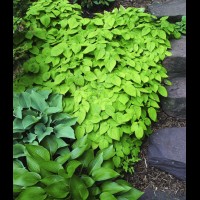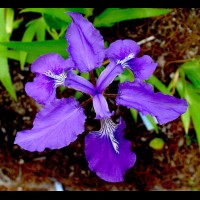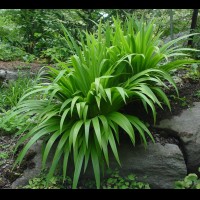Epimedium grandiflorum 'Bicolor Giant'
E. grandiflorum ‘Bicolor Giant’ (Cc. 970206)
Bold, cheerful and bright flowers and later the large leaves both make a nice show from a distance. The large flowers exhibit in-curved sugary pink spurs under wide, deep raspberry sepals. The flowers bloom from underneath the leaves, but are produced in such profusion, that they are showy nonetheless.
After bloom, the large new spring leaflets blush with red before turning to their summer green. Another giant red similar to ‘Red Queen’ and ‘Orion’, but with a bi-colored bloom. Acquired in from Gotemba Nursery, Japan in 1997 as a “pink grandiflorum”. 16” tall in flower. It has exhibited yellow, rusty orange and maroon fall colors here in Massachusetts. Forms a substantial clump that reads as a small shrub in the perennial border.
Epimedium grandiflorum 'French Braid'
E. grandiflorum ‘French Braid’ (Cc. 960042)
***2007 Cobblewood Introduction***
This eye-catching, vigorous, bold-foliaged seedling from Harold Epstein’s garden stands out from the pack with its bright, almost tropical spring leaf coloration. A psychedelic shade of orange flushes the edge of the leaflets that are dissected by luminous chartreuse veins flowing into an all green center. Large, elongated, overlapping leaflets tumble downward in a zig-zag pattern. Large creamy white flowers are borne underneath the expanding leaflets. 14” in bloom.
Epimedium grandiflorum 'Orion'
E. grandiflorum ‘Orion’ (Cc. 920020)
A giant “red" flowered Epimedium, probably originating from central Honshu in Japan. Grows 14 to 18” tall at bloom time, with large leaflets, and no second flush of growth. Large violet-red flowers are produced in profusion held below the large, bold leaflets. Flower color reads from a distance in the garden. Named by Dick Weaver.
Epimedium grandiflorum 'Red Queen'
E. grandiflorum ‘Red Queen’ (Cc. 950055)
Harold Epstein bought this imposing plant in Japan many years ago, and nicknamed it “Red Queen”. As far as we can determine, it was not a named cultivar. Large, vivid, rose-red flowers peek out from under huge leaflets that may grow to 6” long/4” wide. The bold fall foliage of this regal Epimedium sometimes turns shades of pink/orange. A second growth flush of red-tinted foliage reaches to 14”. A vigorous, bold-textured choice that makes a substantial clump over time.
Epimedium grandiflorum 'Waterfall'
E. grandiflorum ‘Waterfall’ (Cc. 950113)
***2003 Cobblewood Introduction***
A large, lively, textural garden plant, full of movement. This appeared as a spontaneous seedling in the garden of Harold Epstein between E. grandiflorum f. flavescens ‘La Rocaille’ and E. grandiflorum ‘Yubae’. The medium-large, acutely tapered leaves stack in layers giving the appearance of flowing water. In spring, purple stippling is strongest at leaf edge, with an irregular mosaic of purple/red and green in the center, fading to green at the petiole. Large flowers gush forth on stems angled upward along the fringes of the foliage. Deep rose-purple sepals angle back from white spurs that flush amethyst as they near the narrow cup. 16” in bloom with colorful second growth to 20".
Epimedium grandiflorum 'White Queen'
E. grandiflorum ‘White Queen’ (Cc. 950168)
Common in the U.K., but quite rare in the U.S., Darrell received his original start of this cultivar from Dan Hinkley upon their first meeting in 1995. ‘White Queen’ has handsome, medium-sized, dark green arrow-shaped leaflets on stems to 14”. It produces no second growth flush. The edges of leaflets are flushed red in spring, while masses of large pure white flowers bloom just below the foliage.
Epimedium grandiflorum f. flavescens #2
E. grandiflorum f. flavescens #2 (Cc. 940550)
Of the over 50 distinct clones of E. grandiflorum f. flavescens that Darrell brought back from Japan, this is by far the earliest to bloom with large, pale greenish-yellow flowers held below large, elliptical, bright apple green leaflets. Large, mature leaflets etched by the nearly parallel main veins make a bold, elegant garden statement. From the Kyoto Botanic Garden in Japan, it is very different from other clones circulating in the U.S. 20" tall. Clear yellow fall foliage. Spreads by 2-4" rhizomes.
Epimedium grandiflorum f. flavescens #3
Epimedium grandiflorum f. flavescens #3 (Cc. 950129)
Originally sold by Siskiyou Rare Plant Nursery under the invalid name E. macranthum ‘Aureum’. At 14”, it is shorter than most other E. grandiflorum f. flavescens clones offered here. Beautiful red-copper young leaflets unfurl over large, pale yellow flowers. After bloom, large, bold, oval-shaped leaflets expand to form an impressive mound. Clear yellow fall foliage color. Spreads by 2-4" rhizomes.
Epimedium grandiflorum f. flavescens #4
E. grandiflorum f. flavescens #4 (Cc. 960021)
Very different from other forms in commerce—almost like a straight E. grandiflorum. 20” tall, with 27 small leaflets per leaf, lightly bronze-tinted in spring. Large soft yellow flowers are held out from beneath the many small leaflets on long peduncles. Thin, wiry red stems arch out over the flowers, enhance the overall graceful textural nature of this clone.
Epimedium grandiflorum f. flavescens #5
E. grandiflorum f. flavescens #5 (Cc. 970232)
Reminiscent of E. koreanum ‘Harold Epstein’, with large soft yellow flowers and huge rounded leaflets, nearly as broad as long. However, its spreading rhizomes only grow 2-6” per year, forming a much thicker mass in the garden. Large, light yellow flowers held below the emerging foliage. 20” tall. Rusty red fall color.
Epimedium grandiflorum f . flavescens #6
Epimedium grandiflorum f. flavescens #6
Cc. 950188
Distinctive for the exaggerated extra points on each terminal leaflet. In spring, the large leaflets have a thin dark bronze edging with an overall light bronze blush. The smooth leaf surface and very delicate spring coloration creates a soft effect. Sizeable clusters of large, showy, pale yellow flowers are borne on long sprays beneath the leaves as they unfurl. 16” in bloom, to 20” tall. Spreads 2-4" per year.
Epimedium grandiflorum forma flavescens "Aomori Forms"
E. g. f. flavescens “Aomori Forms” (Several clones/Cc. #)
Prof. Stearn’s 1938 Epimedium monograph mentions “Faurie’s robust specimens from Aomori in Honshu, Japan”. Darrell explored the region in 1997. After several inquiries, their host led them to a steep hillside of densely planted Cryptomeria japonica, beneath which grew knee-high Epimediums with leaflets the size of your hand! Spring leaflets often flushed bronze-purple on 15-24” stems. Large, light yellow flowers open beneath the unfurling leaves. Rhizomes spread 2-4” a year, creating massive clumps over time.
Epimedium grandiflorum f. flavescens 'LaRocaille'
Epimedium grandiflorum f. flavescens ‘La Rocaille’ (Cc. 950040)
Originally offered in the 1970’s as E. grandiflorum f. flavescens by George Schenk of The Wild Garden, Bothel, WA. Plants established in Harold’s garden 25 years before grew into a large mass 6’ across. Its vigorous habit, long arrow-shaped leaflets and large, pale yellow flowers moved Harold to name it after his garden. Foliage is flushed a beautiful red in spring. 14” tall.
Epimedium koreanum 'Harold Epstein'
Epimedium koreanum ‘Harold Epstein’ (Cc. 930004)
A very cold hardy clone with huge flowers for an Epimedium— gorgeous and butter yellow. Named in honor of Harold Epstein by plantsman Jerry Flintoff, its enormous leaflets can reach over 6” long and 4-1/2" wide. Spreads 6-12" a year. It usually takes 2-3 years to establish itself and become most impressive. The flowers emerge before the leaflets unfurl in early spring. E. koreanum is notorious for just putting up one set of leaves per node each season. If the leaf suffers damage, the rhizome will remain dormant until the following year. ‘Harold’ is a great bold-textured vigorous ground cover for large areas where it can spread unimpeded. It is especially useful in combination with early spring bulbs for sequential bloom. After bloom the expanding leaves serve as camouflage for the dying bulb foliage. 15" tall.
Epimedium sagittatum 'Warlord'
E. sagittatum ‘Warlord’ (Cc.021191)
2007 Cobblewood Introduction
A very handsome species, long desired for its exceptionally large, arrow-shaped, evergreen leaflets up to 9” long (in fertile soil and full shade). The spring foliage color of this clone is a spectacular mosaic of various shades of maroon covering the entire leaflet. Side leaflets have exaggerated outer lobes. Tiny flowers with white inner-sepals and golden spurs, are produced in congested panicles of 50 or more against the dark, glossy foliage. Grows to 18” tall here with much more narrow leaflets than the typical species. A slow grower, it forms an impressive clump over time.
Epimedium 'Domino'
Epimedium ‘Domino’ (Cc. 990614)
***2004 Cobblewood Introduction***
Absolutely stunning in the garden-- a true specimen epimedium. Long, showy panicles of creamy white flowers with an abbreviated maroon cup are highlighted against handsome mottled foliage in spring. Elegant elongated spring leaflets are sponge-painted in various shades of maroon. Deep reddish-purple outer sepals and dark purple pedicels. Forms a 12-14" mound of spiky evergreen foliage with soft spines, covered in a halo of long flower stems to 16”. May re-bloom and produce a second flush of mottled new growth to 18" under favorable conditions of humus-rich soil and adequate moisture.
Epimedium 'Hot Lips'
Epimedium ‘Hot Lips’ (Cc. 031434)
An E. acuminatum hybrid from Diana Reeck of the former Collector's Nursery, with multi-toned flowers of hot pink with the long spurred petals that are decidedly hotter than the broad sepals. Flower stems are tinged burgundy red. Long narrow foliage emerges a reddish pink. Given a bit of bright shade or moderate sun in the north, the plant can reach 20” high. Its bright blooms and bold semi-evergreen foliage draws your eye from quite a distance.
Epimedium 'Pink Champagne'
Epimedium ‘Pink Champagne’ (Cc. 990618)
***2007 Cobblewood Introduction***
Perhaps the most all around beautiful Epimedium of those that Darrell has developed so far! Upright, heavy flowered panicles of pink and raspberry flowers float well above handsome, mottled foliage in spring. Medium pink sepals cap the top of each widely-arched spur. From the yellow spur tips that reveal their treasure of nectar, the color changes from white to a rich, berry pink, as if the cup was dipped in raspberry sorbet. Elongated, evergreen medium-sized arrow-shaped leaflets contrast purple mottling against a green background. A vigorous grower, it puts on an incredible show with occasional re-bloom if it is happy in its environment. 12" tall with flower stems reaching 16".
Epimedium x rubrum 'Sweetheart'
Epimedium x rubrum ‘Sweetheart’ (Cc. 930007)
***1997 Cobblewood Introduction***
This cultivar easily rivals Hosta as a bold textural garden accent. The first of Darrell Probst's Epimedium introductions, resulting from a 1991 cross he made between E. sempervirens ‘Candy Hearts’ and E. alpinum. Flowers with dark rose-red sepals bloom above and below the leaves. Leaflets are much larger, darker green and more rounded than is typical. Large, shiny new leaflets bear a thin red rim in spring. Semi-evergreen. 16" tall. Foliage is far superior to E. x rubrum, and the plant is much more drought-tolerant. Spreads by 2-4" rhizomes.
Iris tectorum 'Slippery Slope'
Iris tectorum ‘Slippery Slope’
***2010 Cobblewood Introduction***
Darrell has failed endless times growing the Japanese roof iris in our climate. The flower buds die over winter, starting a rot that eventually kills the plant. He collected this much hardier clone at a high elevation in the Dabashan region of southern Shaanxi Province, China. Here they were pulled up and over the icy mountain by a coal truck in Nov. 2000, hence the cultivar name.
This clone thrives in half sun on an exposed stony ridge in my garden. Best with sharp drainage in light shade/part sun. Large 4” violet blossoms emerge in late spring from 2’ × 2’ bright green foliage fans, giving a tropical appearance to an otherwise New England perennial garden. Spreads slowly, 2-5". per year, by fleshy rhizomes to form a massive clump over time, so give it some elbow room! Needs division every 3-4 years for maximum vigor.
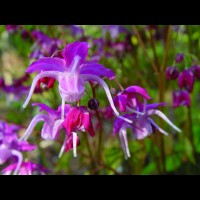


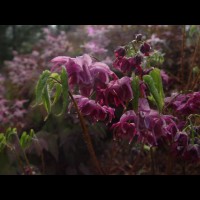
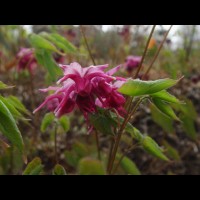
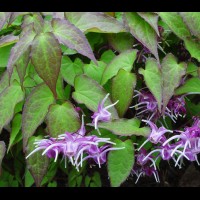
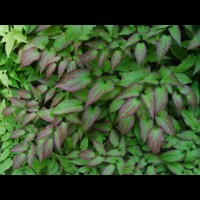
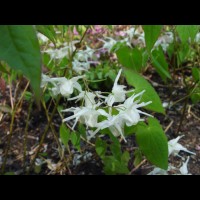

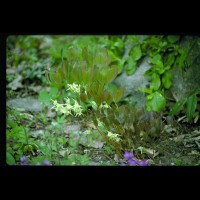
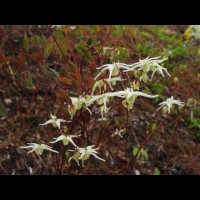
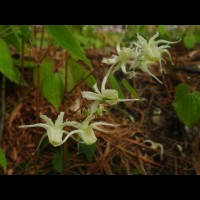
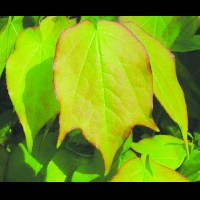

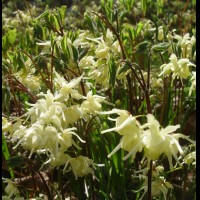
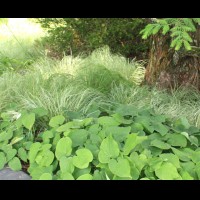
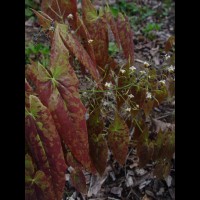
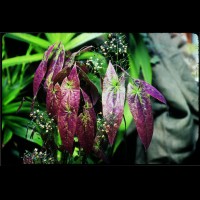
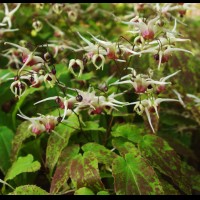
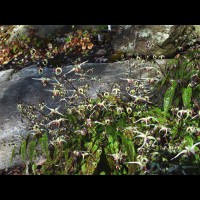
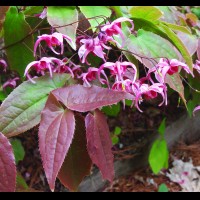

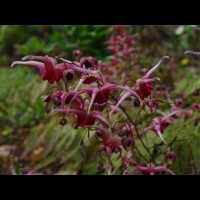
.jpg)
.jpg)
